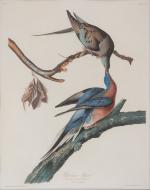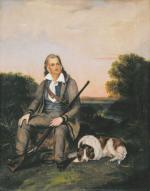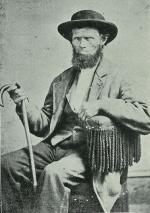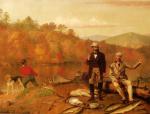Chapter Three: Creatures Great and Small
Before the arrival of Columbus, Pennsylvania was a Noah's ark of diversity. The variety and sheer numbers of the wildlife and fish astounded the first European explorers. Here was a hunter's Eden, filled with wild turkeys that weighed close to fifty pounds,  elk as big as small ox and deer so plentiful "that their tracks in the wheat field in time of snow, were as if marked by a flock of sheep." Bear, moose, and other game were there for the taking. There were countless
elk as big as small ox and deer so plentiful "that their tracks in the wheat field in time of snow, were as if marked by a flock of sheep." Bear, moose, and other game were there for the taking. There were countless  beaver, whose thick, soft coats were just waiting for the harvesting, and flocks of wild
beaver, whose thick, soft coats were just waiting for the harvesting, and flocks of wild  pigeons so thick that they obscured the sun for two to three hours at a time.
pigeons so thick that they obscured the sun for two to three hours at a time.
The explorers also found strange creatures unknown in Europe: massive, shaggy-coated bison, squirrels that flew, flies that illuminated the night, and a curious creature that feigned death when frightened and carried its young in a pouch which the Indians called "opossum." On summer nights in the marshes and forests, millions of frogs and insects created a deafening chorus, punctuated by the howls of gray wolves and screams of panthers.
The waters of Pennsylvania boasted an equal extravagance of riches. The Dutch and English who sailed up the Delaware River discovered more than 300 species of fish, including great numbers of catfish, lamprey, eel, trout, smelt, sunfish and an occasional whale. Charting the river in the winter of 1632-33, Dutch explorer David De Vries wrote of waters so filled with fish that one drop of a net caught as many perch, roach and pike as thirty men could eat in a day.
thirty men could eat in a day.
Early settlers wrote of aloes so plentiful that a single dip of the net could pull in 600; herring that ran in shoals so thick you could almost shovel them into tubs; and rockfish so abundant you could barrel them like cod. Explorers to the interior found streams filled with trout and bass. Two great river systems, the Susquehanna and the Ohio, boasted an even greater variety of fish than the Delaware.
Fascinated by the plants and animals of North America, naturalists like John Bartram and the young Frenchman
John Bartram and the young Frenchman  John James Audubon wandered the woods and plains of North America seeking out new species. In Europe, where game had become scarce centuries before, laws permitted only the nobility and the rich to hunt. Poaching was a serious crime punishable by imprisonment or death. Astonished by the bounty that "God, in his Providence, hath freely afforded," William Penn granted settlers the "liberty to fowl and hunt upon the lands they hold, and all other lands therein not enclosed; and to fish in all waters in the said lands, and in all rivers and rivulets in, and belonging to,
John James Audubon wandered the woods and plains of North America seeking out new species. In Europe, where game had become scarce centuries before, laws permitted only the nobility and the rich to hunt. Poaching was a serious crime punishable by imprisonment or death. Astonished by the bounty that "God, in his Providence, hath freely afforded," William Penn granted settlers the "liberty to fowl and hunt upon the lands they hold, and all other lands therein not enclosed; and to fish in all waters in the said lands, and in all rivers and rivulets in, and belonging to,  this province and territories thereof." Imagine the wonder. Here a man could eat like a king and make a fortune with his gun, traps and nets.
this province and territories thereof." Imagine the wonder. Here a man could eat like a king and make a fortune with his gun, traps and nets.
Settlers took Penn at his word. For the next 200 years, Pennsylvanians took to his woods to hunt, trap, and fish to their heart's content. Then, by fires and bedsides, they told stories of the exploits of Daniel Boone and the other great hunters of Penn's woods.
Daniel Boone and the other great hunters of Penn's woods.
By 1700, deer were already so scarce near Philadelphia that Penn's representatives passed the province's first game law, which prohibited the hunting of deer between January and the end of June. In the following centuries, more laws were added to ensure the survival of game for all. But the laws were difficult, if not impossible to enforce - and the wildlife disappeared. First to go was the wolf - which had a bounty on its head - then the panther and the elk.
In the nineteenth century, Pennsylvanians enjoyed one last frenzied banquet. While the farmers and lumbermen clear-cut the forest, market hunters slaughtered the wildlife. Fish once so abundant disappeared as the rivers and streams were dammed, silted, polluted and over-fished. The millions of shad, which since before the arrival of humans had left their Atlantic Ocean feeding grounds to spawn in the rivers and streams of the Susquehanna and Delaware, all but disappeared.
shad, which since before the arrival of humans had left their Atlantic Ocean feeding grounds to spawn in the rivers and streams of the Susquehanna and Delaware, all but disappeared.
When the big game were gone, market hunters and sportsmen slaughtered the duck, geese and shore birds that passed through the state each year on their annual migrations. Farmers and factory workers killed the songbirds, rabbits and other small game. The bison and the wolf, the panther and the elk, the Big Deer, the passenger pigeon and other animals once native to the state became extinct within its borders, as did nearly all of the white-tailed deer, beaver, fisher martens, wolverines, upland plover, black bears, wild turkeys, ruffed grouse, fox squirrels and many migratory waterfowl.
In the late nineteenth century, Americans finally recognized what they were losing and began the long campaign for wildlife restoration. In Pennsylvania, as elsewhere, the campaign was led by well-to-do hunters and fishermen who found an escape from the tensions of modern city life in the nation's woods and along the banks of its streams.
In the decades before the Civil War, Pennsylvanians Thad Norris and Samuel Phillippe had provided recreational anglers the know-how and equipment to better catch their increasingly elusive prey. Soon the anglers joined the food fishermen to lobby for restoration of fish to the state's waters. In 1866 the state legislature created the Pennsylvania Fish Commission. To restore the shad runs, the commission ordered the Susquehanna Canal Company and other dam owners to place fishways on their dams.
Samuel Phillippe had provided recreational anglers the know-how and equipment to better catch their increasingly elusive prey. Soon the anglers joined the food fishermen to lobby for restoration of fish to the state's waters. In 1866 the state legislature created the Pennsylvania Fish Commission. To restore the shad runs, the commission ordered the Susquehanna Canal Company and other dam owners to place fishways on their dams.
In 1895 the Commonwealth created a State Game Commission to oversee habitat restoration and reintroduction and management of wildlife. In the twentieth century, the state passed stricter wildlife-protection laws and better enforced those that were already on the books. The Fish and Game Commissions re-introduced elk from Wyoming, beaver from Canada, white-tailed deer from Michigan, cottontail rabbits from Kansas and Missouri and quail from Mexico. Using the fees paid each year by hunters and fishermen, they set up hatcheries and nurseries to restock the state's streams and forests with shad, trout, ruffled grouse, pheasant and other species. To provide refuges for wildlife protection and breeding, the Game Commission purchased and maintained a system of game refuges that included more than 1.3 million acres in the year 2000.
a system of game refuges that included more than 1.3 million acres in the year 2000.
When the trees grew back and the pollutants once poured into the streams were better controlled, many of the fish and animal populations recovered, and new species like the coyote established themselves in the state. At the end of the twentieth century, hunting and fishing generated more than a $1 billion a year for Pennsylvania's economy. Today, its state parks draw millions of people to observe the creatures, great and small, that again inhabit the woods, waters, meadows and skies of Pennsylvania. The threats to the state's wildlife, however, are far from over.
Mine runoff and other toxic discharges by state industries continue to pollute the state's streams and rivers, kill aquatic life, and make game fish unfit for human consumption. Acid rain has reduced the number of amphibians, trout and other fish sensitive to pH levels in thousands of miles of state streams, and killed off the aquatic insects upon which they feed. Migratory bird populations are threatened by habitat destruction. Zebra mussels in Lake Erie and other invasive species from abroad compete with native species for food and habitat.
All but gone from Penn's woods at the beginning of the twentieth century, deer now exist in unprecedented numbers and overgraze the forest understories, contribute to the spread of Lyme disease and cause thousands of motor vehicle accidents each year. Pennsylvania's ecosystems are in the midst of transformations perhaps more rapid, and just as radical, as any in recorded history.
The explorers also found strange creatures unknown in Europe: massive, shaggy-coated bison, squirrels that flew, flies that illuminated the night, and a curious creature that feigned death when frightened and carried its young in a pouch which the Indians called "opossum." On summer nights in the marshes and forests, millions of frogs and insects created a deafening chorus, punctuated by the howls of gray wolves and screams of panthers.
The waters of Pennsylvania boasted an equal extravagance of riches. The Dutch and English who sailed up the Delaware River discovered more than 300 species of fish, including great numbers of catfish, lamprey, eel, trout, smelt, sunfish and an occasional whale. Charting the river in the winter of 1632-33, Dutch explorer David De Vries wrote of waters so filled with fish that one drop of a net caught as many perch, roach and pike as
Early settlers wrote of aloes so plentiful that a single dip of the net could pull in 600; herring that ran in shoals so thick you could almost shovel them into tubs; and rockfish so abundant you could barrel them like cod. Explorers to the interior found streams filled with trout and bass. Two great river systems, the Susquehanna and the Ohio, boasted an even greater variety of fish than the Delaware.
Fascinated by the plants and animals of North America, naturalists like
Settlers took Penn at his word. For the next 200 years, Pennsylvanians took to his woods to hunt, trap, and fish to their heart's content. Then, by fires and bedsides, they told stories of the exploits of
By 1700, deer were already so scarce near Philadelphia that Penn's representatives passed the province's first game law, which prohibited the hunting of deer between January and the end of June. In the following centuries, more laws were added to ensure the survival of game for all. But the laws were difficult, if not impossible to enforce - and the wildlife disappeared. First to go was the wolf - which had a bounty on its head - then the panther and the elk.
In the nineteenth century, Pennsylvanians enjoyed one last frenzied banquet. While the farmers and lumbermen clear-cut the forest, market hunters slaughtered the wildlife. Fish once so abundant disappeared as the rivers and streams were dammed, silted, polluted and over-fished. The millions of
When the big game were gone, market hunters and sportsmen slaughtered the duck, geese and shore birds that passed through the state each year on their annual migrations. Farmers and factory workers killed the songbirds, rabbits and other small game. The bison and the wolf, the panther and the elk, the Big Deer, the passenger pigeon and other animals once native to the state became extinct within its borders, as did nearly all of the white-tailed deer, beaver, fisher martens, wolverines, upland plover, black bears, wild turkeys, ruffed grouse, fox squirrels and many migratory waterfowl.
In the late nineteenth century, Americans finally recognized what they were losing and began the long campaign for wildlife restoration. In Pennsylvania, as elsewhere, the campaign was led by well-to-do hunters and fishermen who found an escape from the tensions of modern city life in the nation's woods and along the banks of its streams.
In the decades before the Civil War, Pennsylvanians Thad Norris and
In 1895 the Commonwealth created a State Game Commission to oversee habitat restoration and reintroduction and management of wildlife. In the twentieth century, the state passed stricter wildlife-protection laws and better enforced those that were already on the books. The Fish and Game Commissions re-introduced elk from Wyoming, beaver from Canada, white-tailed deer from Michigan, cottontail rabbits from Kansas and Missouri and quail from Mexico. Using the fees paid each year by hunters and fishermen, they set up hatcheries and nurseries to restock the state's streams and forests with shad, trout, ruffled grouse, pheasant and other species. To provide refuges for wildlife protection and breeding, the Game Commission purchased and maintained
When the trees grew back and the pollutants once poured into the streams were better controlled, many of the fish and animal populations recovered, and new species like the coyote established themselves in the state. At the end of the twentieth century, hunting and fishing generated more than a $1 billion a year for Pennsylvania's economy. Today, its state parks draw millions of people to observe the creatures, great and small, that again inhabit the woods, waters, meadows and skies of Pennsylvania. The threats to the state's wildlife, however, are far from over.
Mine runoff and other toxic discharges by state industries continue to pollute the state's streams and rivers, kill aquatic life, and make game fish unfit for human consumption. Acid rain has reduced the number of amphibians, trout and other fish sensitive to pH levels in thousands of miles of state streams, and killed off the aquatic insects upon which they feed. Migratory bird populations are threatened by habitat destruction. Zebra mussels in Lake Erie and other invasive species from abroad compete with native species for food and habitat.
All but gone from Penn's woods at the beginning of the twentieth century, deer now exist in unprecedented numbers and overgraze the forest understories, contribute to the spread of Lyme disease and cause thousands of motor vehicle accidents each year. Pennsylvania's ecosystems are in the midst of transformations perhaps more rapid, and just as radical, as any in recorded history.
















